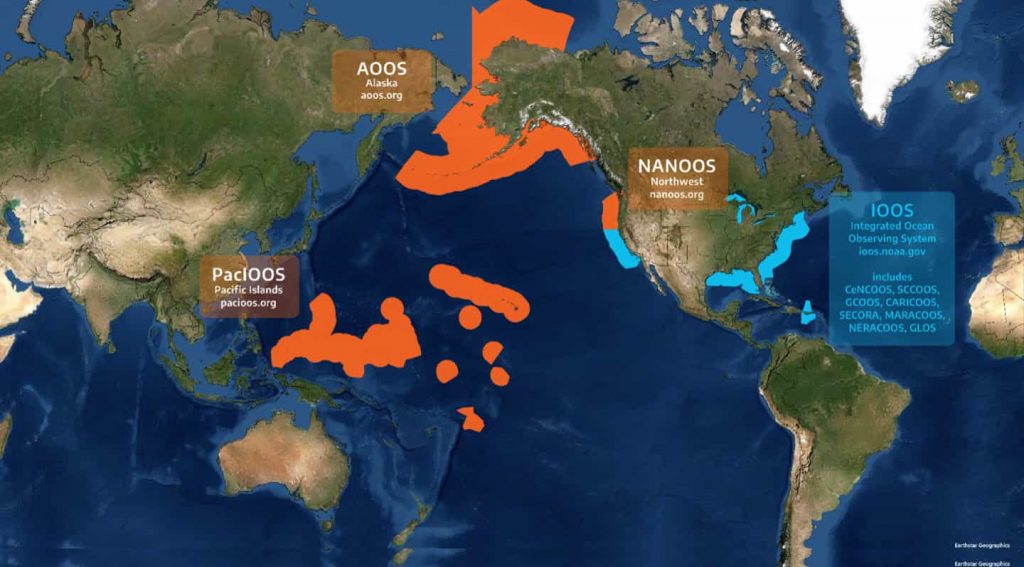Backyard Buoys awarded $4.98M cooperative agreement with National Science Foundation to improve ocean data access for Indigenous communities
Backyard Buoys empowers Indigenous and other coastal communities in the Pacific Northwest, Alaska, and the Pacific Islands to collect, steward, and use wave data that complements their existing knowledge to support their blue economy: maritime activities, food security, and coastal hazard protection.
The project is one of six Phase II projects aligned to the Track E: Networked Blue Economy and funded through the National Science Foundation (NSF) Convergence Accelerator, a program created to find solutions to large-scale societal challenges through research, innovation, and partnerships. In the initial phase (Phase I) of the Backyard Buoys project, partners engaged 15 communities from the three regions to identify community priorities and needs and determine how wave buoy technologies can address those needs and broader goals. Funds from NSF will continue to advance the convergent efforts of the project into the second phase (Phase II).
The initiative brings together a geographically and culturally diverse group of partners that include three regional associations of the U.S. Integrated Ocean Observing System (NANOOS in the Pacific Northwest, AOOS in Alaska, and PacIOOS in the Pacific Islands); Indigenous and education partners from each region; and a wave buoy and sensor company known as Sofar Ocean. Together, they are collectively working to close the gap in access to coastal and ocean data, especially for Indigenous communities in remote coastal areas.
“This award will allow us to continue our efforts in co-designing technologies and techniques with Indigenous community members in ways that complement their knowledge,” explains Principal Investigator Jan Newton. “The wave buoy systems will collect critical real time wave information that can serve to increase awareness and understanding of changes in the ocean and climate.”
A critical factor in the co-designed project is listening to the Indigenous community partners about their ideas:
“This project has the ability to bridge local Indigenous knowledge and scientific data collection making the information needed for ocean safety decisions more accessible and relevant to our local community,” states Fuiava Bert Fuiava, Samoan Village Chief, American Samoa.
“Nearshore wave data will help prepare for and mitigate impacts from a changing environment that threatens the livelihood and homes of Quinault tribal members,” said Joe Schumacker, Quinault Indian Nation.
According to Lesley Hopson, Alaska Eskimo Whaling Commission Executive Director, “What appealed to us about the project at the AEWC is that it has a collaborative approach, and it is community-led and community-driven. Our whaling communities are located along the arctic coast of Alaska and rely on the resources from the sea to feed our communities. The sea can be very unforgiving and dangerous, and it changes all the time. This technology will allow us to improve safety for our hunters and better understand environmental changes.”
Indigenous communities involved will be the ultimate stewards of the wave buoys within their own waters throughout the project and beyond. They will identify where the buoys should be deployed, when, why, and how they should be operated in a way that meets their needs and goals.
Beginning in Phase II and continuing into the future, the Backyard Buoys project aims to deploy over 50 wave buoys to serve Indigenous communities across the three regions. This goal will be achieved by implementing Community Research Implementation and Stewardship Plans (CRISPs), which have been co-designed with Indigenous partners in Phase I to guide community stewards in the deployment, maintenance, and stewardship of the wave buoy systems within their own waters. We are modularizing a CRISP-building tool that will enable broad participation in developing stewardship plans. Additionally, two data applications will be co-developed, allowing users to access real time wave data generated by the wave buoys and other relevant forecasts.
With accessible data tools, these data will serve community needs for decisions on scales from daily (e.g., related to assessing safety for maritime operations and coastal hazards) to longer planning horizons (e.g., related to assessing resilience for climate change and ecosystem function).
Building local capacity within communities is another core focus of the project. Hands-on training will be conducted and tailored for providing technical support on buoy operations and data interpretation. Working groups will be established to share knowledge, experiences, and lessons learned. Another key component is developing educational materials that integrate both ocean data and Indigenous knowledge to help engage local students, teachers, village residents, and tribal leaders in wave buoy stewardship.
The longer-term goal is for these observing assets to remain operational within each of the communities beyond the scope of the Phase II project effort, and to expand the realized observing capacity to other Indigenous communities in other regions across the U.S. The Phase I co-production collaborators have been highly engaged and are motivated and excited to participate in the Phase II implementation of the Backyard Buoys project they co-developed.

By piloting in three disparate regions with diverse environmental conditions, the project provides invaluable insight, as well as comprehensive field testing that can be replicated in other locations globally and extended to other efforts worldwide.
The CRISP-building tool will be built with insights from three very diverse regions (environmentally, culturally) with the aim to be used outside of this project, anywhere around the world, in order to provide underserved communities the foundation to obtain the ocean data they need, where, and when they need it.
PIs and partner organizations:
- Pacific Northwest (PI Jan Newton): Northwest Association of Networked Ocean Observing Systems (NANOOS), Quileute Tribe, Quinault Indian Nation, Western Washington University (WWU).
- Alaska (co-PI Sheyna Wisdom): Alaska Ocean Observing System (AOOS), Alaska Eskimo Whaling Commission (AEWC), University of Alaska Fairbanks (UAF), Alaska Department of Natural Resources (ADNR), and Alaska Native Science & Engineering Program (ANSEP).
- Pacific Islands (co-PI Melissa Iwamoto): Pacific Islands Ocean Observing System (PacIOOS), Marshall Islands Conservation Society (MICS), National Park of American Samoa (NPSA), Hawaiʻi Sea Grant, Conservation International Hawaiʻi.
- Sofar Ocean Technologies (co-PI Tim Janssen)
- Consultant: co-PI Sebastien Boulay